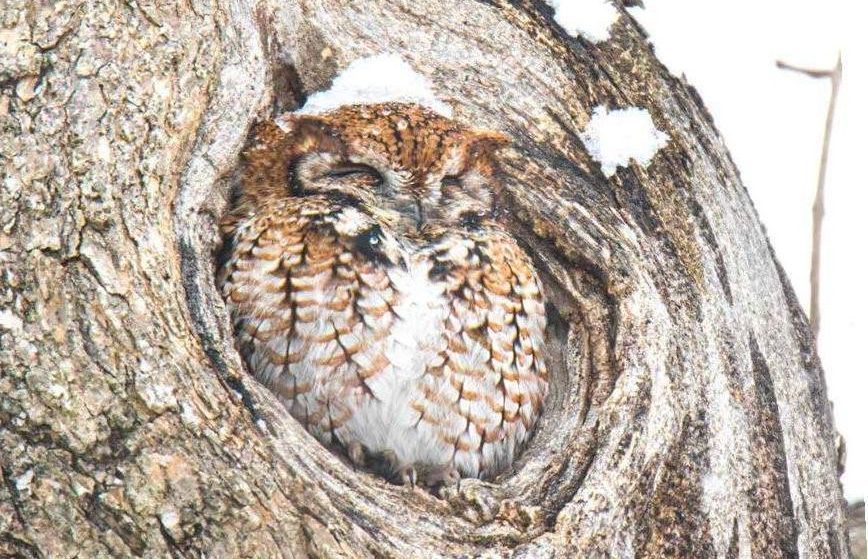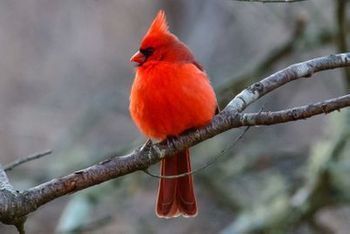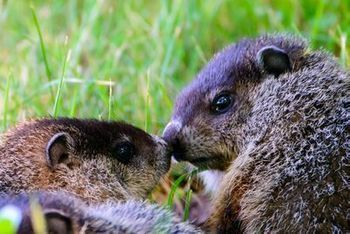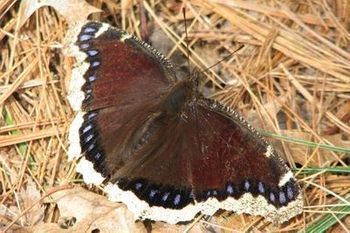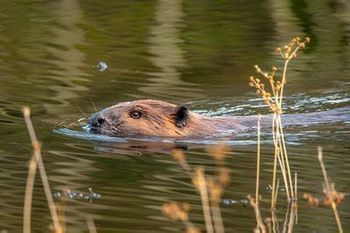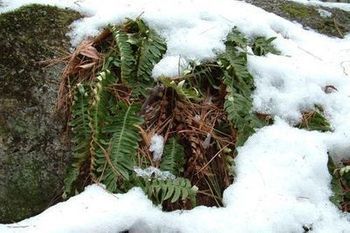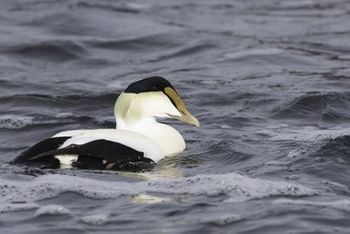Published December 19, 2020
Winter Wildlife Survival Strategies
By Todd McLeish
The shorter days and declining temperatures in autumn are a key signal to wildlife that it’s time to make preparations for winter. For some, that means changing their diet, bulking up, and taking off for distant destinations with warmer temperatures. Others stockpile food in anticipation of a long winter nap, while those that remain active throughout the winter make more modest preparations. Yet for all New England wildlife, the steps they take to prepare for winter are vital to their survival.
-
While humans may take their cozy homes for granted when winter sets in, the strategies that wildlife have developed to cope with the plunging temperatures, biting wind and lack of food are as creative and innovative as they are necessary.
In the bird world, the best-known strategy for surviving the cold of winter is to avoid it entirely. Every year, tens of millions of birds from throughout the region, especially those that rely on insects as their primary food source, migrate south to escape the chill.
“The majority of birds that migrate do so less because of the cold weather and more because they eat insects and need to go somewhere that’s warm enough for them to find enough food to hold them over through the winter,” said Laura Carberry, manager of the Fisherville Brook Wildlife Refuge and one of Audubon’s resident bird experts. “They don’t stay in the south year-round because there’s so much competition with other birds for breeding sites and food resources, so they come back up here to breed.”
-
SNOW BUNTINGS: These birds are used to extreme cold as they breed in the high Arctic. In Rhode Island, Snow Buntings are strictly found in winter as they migrate south to avoid the coldest of temperatures. They can be found in flocks, foraging for seeds in open winter fields and along the coast. In the Arctic tundra, the males are generally black and white in color, and the females are more brown. But when they migrate south, their plumage turns a mix of white and sand that camouflages with shorelines and snow. (Image: Ed Hughes)
-
In anticipation of migrating, Carberry said that some birds can switch to fat-enriched foods like berries to provide them with the energy reserves to power their way south. “If they don’t have those fat resources, they won’t survive migration,” she said.
Migration is a risky strategy, because traveling great distances to Central America, South America and the Caribbean the destination for most of the migrating songbirds from the Northeast is fraught with danger. Between the physiological toll it takes on their bodies, the challenges of navigating long distances at night, the risks of collisions with human obstacles like buildings, and the potential for encountering predators makes it one of the natural world’s most challenging endeavors. But for many species, it works.
Birds aren’t the only animals that migrate, however.
-
CARDINALS: Easy to spot against winter’s snow, Cardinals (like many birds that overwinter in New England) will puff up into the shape of a little round ball to minimize heat loss. Feathers provide wonderful insulation. They are likely to visit your yard if you provide a feeder containing black oil sunflower seed. (Image: Ed Hughes)
In mountainous regions, some animals like deer and elk migrate vertically from upper elevations to valleys to escape the snow and freezing conditions. Some butterflies and dragonflies, most notably monarchs, migrate long distances to escape the cold and to find their preferred food, too. Others, like bats, migrate to sites with the precise environmental conditions they require for their winter hibernation. In the case of Rhode Island’s bats, most migrate in the opposite direction of the birds they go north to caves and mines in New Hampshire, Vermont and northern New York.
-
Speaking of hibernation, a wide variety of wildlife choose some version of winter sleeping as a means of escaping the cold weather without actually leaving the area. Bats and woodchucks are among our only true hibernators, which means they slow their metabolism, heart rate, respiration and other physiological factors to reduce their energy consumption and enter a deep sleep through the winter months.
Chipmunks, bears and skunks, do something similar, but they occasionally wake up to grab a snack, perform some bodily functions, and maybe even wander around a bit before returning to their winter sleep. “This strategy allows them to conserve energy but still have the flexibility to become active again when they need to,” said Scott Ruhren, Audubon’s senior director of conservation. Squirrels and raccoons, on the other hand, only go into a deep sleep for a few days or weeks at a time when the weather is particularly uncomfortable.
-
WOODCHUCKS: The woodchuck is one of Rhode Island’s only true hibernators. They slow their metabolism, heart rate, respiration and other physiological factors to reduce their energy consumption and enter a deep sleep through the winter months. Image: Ed Hughes
“As the climate changes and winter temperatures rise, we may end up with fewer true hibernators and more occasional sleepers because they won’t really need to totally hibernate anymore,” added Carberry.
-
Most reptiles and amphibians choose a strategy similar to hibernation, but in their case it’s called brumation. Snakes and salamanders seek out underground dens to escape the winter weather, and most turtles and frogs bury themselves in the mud at the bottom of ponds or in burrows.
Wood frogs undergo what may be the most radical change to sustain themselves through the winter. They hunker down under the leaf litter on the forest floor and freeze solid.
“They essentially become frogsicles,” Ruhren said. “They use a natural antifreeze in their blood to keep ice crystals from forming, but otherwise they’re frozen solid. You can’t detect a heartbeat or any other signs of life, and yet freezing doesn’t harm them. When the time is right, they can thaw themselves out and come back to life.” And if the weather changes again, they can go through the freezing and refreezing process multiple times during a season. Spring peepers and gray tree frogs can also survive in this way.
-
WOOD FROGS: These frogs use a natural antifreeze in their blood to keep ice crystals from forming, but otherwise they freeze solid. You can’t detect a heartbeat or any other signs of life, and yet when it warms, they thaw themselves out and come back to life.
Insects do something very different, however. In most cases, the adult insects moths, beetles, grasshoppers and others die prior to the onset of winter, but their offspring survive the winter months in earlier life stages. Most butterflies and moths overwinter in a chrysalis or cocoon the stage between caterpillar and adult and are ready to emerge as flying adult insects as soon as the weather warms up. Young spiders often overwinter in egg cases hidden in log piles or under ledges except for those that are hidden in the nooks and crannies inside our homes, where they may remain active all winter.
-
One exception is the mourning cloak, a beautiful brown butterfly with a gold stripe along the edge of their hind wing. They are among the longest-lived butterflies in the world, and they live through the winter in their adult form, hiding in crevices of tree bark or beneath leaves where they are protected from freezing. It’s a strategy that gives them a head-start on springtime, because as soon as the weather warms up a bit, they can be out flying around.
Most colonial insects like bees, ants and wasps overwinter as adults. “Many of them ride out the winter in a big ball of insects, generating heat together and eating food they have stored,” said Ruhren. “In the case of bumble bees, the queen spends the winter alone in her nest, and she’s the first one out in the spring to start a new colony.”
Rather than migrate or hibernate, many animals are well adapted to remaining active in the winter months with just minor adjustments.
-
MOURNING CLOAK BUTTERFLY: While most butterflies overwinter in a chrysalis or cocoon, a mourning cloak will live through the winter in their adult form, hiding in crevices of tree bark or beneath leaves where they are protected from freezing. (Image: Scott Ruhren)
-
White-tailed deer, for instance, shed their coat for a grayer version that’s warmer and provides better camouflage from predators (and hunters). Red squirrels cache their food at the base of a pine tree so it’s easy to find, even under the snow. And beavers, like those at Audubon’s Fisherville Brook Wildlife Refuge in Exeter and Fort Wildlife Refuge in North Smithfield, fortify their dams to make sure they can maintain water levels high enough to allow them to swim under the ice.
“A lot of rodents like beavers are food hoarders,” said Carberry. “Beavers stockpile twigs on the bottom of their pond, which is why it’s so important for them to keep the water level high so they have access to their food in winter. They don’t hibernate, but we don’t see them because they’re either under the ice or in their lodge.”
-
BEAVERS: Although we may not see them during the winter months, beavers don’t hibernate. They stay warm in their lodges, with a stockpile of twigs on the bottom of their pond so they have access to food in winter
How plants survive the winter is a totally different story.
“They can’t move, so they have to deal with whatever conditions are here,” Ruhren said. “And they deal with it in a lot of different ways."
-
Annual plants produce seed and then die off and decompose into the soil, for instance, and hope that their seeds will sustain the next generation. Perennials, on the other hand including trees, shrubs and herbaceous plants pull the nutrients from their leaves and branches to store in their root system and go dormant above ground. That’s why deciduous leaves fall from the trees in autumn because all the nutrients that keep them alive have retreated into the roots.
“Conifers are evergreen because they have a specialized leaf in the form of a needle, which can withstand drought and cold conditions, so they don’t drop like deciduous leaves,” said Ruhren. “Their needles are very waxy with lots of water conservation strategies built into them. Yet even conifers stop growing in winter.”
Trees have added armor, in the form of bark, to insulate and protect the more delicate structures inside the trunk from the extremes of weather. “Trees spend a lot of energy making bark because the ‘vascular system’ of the trees the xylem and phloem that conducts water and nutrients up and down the trunk are right beneath the bark, and that system needs to be protected.”
-
EVERGREEN AND SPLEENWORT FERNS: Though they go dormant, some ferns and woody plants hold onto green leaves in winter. Evergreen native ferns include Christmas fern and many of the spleenworts, a common and widespread group of ferns. Many will still have green leaves during the colder months. (Image: Scott Ruhren)
It’s just one more of the dizzying variety of strategies that local wildlife have evolved to sustain themselves through the challenges of a New England winter.
-
DUCKS: Species of ducks that overwinter in New England have insulating downy feathers that keep them warm. They also can store more fat than most birds and their legs and feet have a counter current heat exchange. The veins that carry cold blood from their feet to the heart are surrounded by arteries that are sending warm blood in the opposite direction. Through this exchange of heat, they require less energy to warm the colder blood coming back to the heart. Ducks will also stand on one leg while the other is lifted and warmed in their feathers.
-
CONIFERS: “Evergreen” is a misnomer as coniferous trees shed old needles while retaining newer ones. Their needles are a specialized leaf which can withstand drought and cold conditions. Needles are very waxy with water conservation strategies built into them. (Image: Glenn Osmundson)
